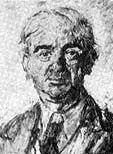DIENER DÉNES, Rudolf
(1889, Nyíregyháza - 1955, Budapest)


"The art philosophy of Diener-Dénes, painter, is linked to the French impressionism and postimpressionism, however without even the slightest hint of the unoriginality of school followers." - Lajos Kassák reported in 1937 on the painter's comprehensive exhibition in his essay published in 'Munka' (Work) and then he carried on: "...He is not an inventor or pioneer, but a par excellence painter, expressive and rich in colours. His style is evidently related to that of Cézanne. (...) There is nothing in his pictures that is crammed within the narrow boundaries of objectivity. His art is not focused on the representation of objects, instead, its essence can be seen in the translation of feelings aroused by objects into memories. This is not transposition, but rather transformation within the soul."
Diener-Dénes had made a long journey before he came under the magic spell of Paris. A childhood burdened with work was his lot. He started as an apprentice at a barber, then in a printing shop and later at a passementerie maker's, and he used the money he earned to move to the capital in 1909 and attend the School of Industrial Drawing and then enrol to the evening classes of the School of Applied Arts. From 1910 to 1913 he studied under the supervision of Károly Ferenczy at the Academy of Fine Arts for three years. From 1911 he would exhibit regularly. In 1917 he was instructed by Béla Iványi Grünwald and later by József Rippl-Rónai at the colony of artists in Kecskemét. His first one-man exhibition was held in the Belvedere Gallery in Váci Street, Budapest, in 1924. He lived in Paris from 1924 to 1931, and he also worked in Bretagne for some time. Although following his return to Hungary he put on show his paintings of France in the Ernst Museum, he received serious appreciation for the first time only during his exhibition of 1937, which was praised by Kassák as quoted above.
From 1931 onward he would paint in Szentendre every summer and from 1946 until his death he was a member of the colony of artists at Szentendre. He depicted what he saw with expressive picturesqueness in his townscapes and interiors of lyric tone and his still-lifes constructed of everyday objects. His oil paintings are complemented with series of pastel drawings and aquarelles in his life's art. His commemorative exhibition was held in 1968 in the Hungarian National Gallery, and the first one-artist show of his oeuvre was possible only in 1982 in the Gallery of the Colony of Artists of Szentendre. A monograph of Francois Gachot on his oeuvre was published in 1976, on the twentieth anniversary of his death.
